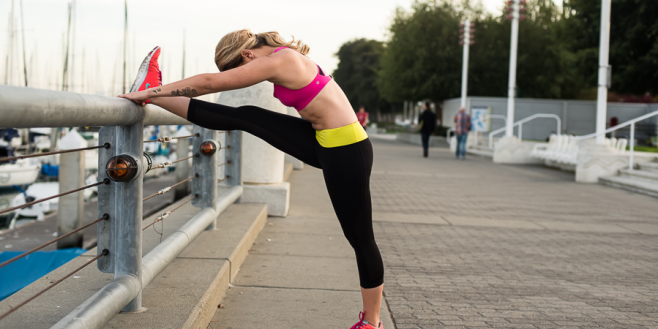by Leigh Weingus, mbg Yoga & Fitness Editor
If you’ve never run a race before—whether it’s a 5K, 10K, or full-on marathon—it can be intimidating. It can also be really hard to know where to start.
Maybe you’re following a training plan or running a few times a week. If so, that’s great! But did you know that there are plenty of ways to prepare for a race that have nothing to do with actually running? In fact, practicing other forms of exercise that don’t involve pounding the pavement sometimes can be more beneficial to your training plan than actually running.
“In order to become stronger in any sport, cross-training is essential,” Charlee Atkins, certified strength and conditioning coach (CSCS) and founder of Le Sweattells mbg. “For a runner, cross-training should be geared toward working the muscles that running does not fully utilize. The desired result in cross-training is to strengthen the non-sport muscles for supplementing the chosen activity (aka running) as well as promoting balance within the body.”
Here are seven ways to prepare for your race that have nothing to do with running:
1. Go for a swim.
“Static pool sprints are a go-to,” professional athlete, sports and conditioning coach Andia Winslow tells mbg. “Stand in chest-high water, sprint as fast as you can for a timed period, then tread water to break, and repeat. This takes the load off the body. Swimming is great for the offseason, great for those who may be recovering from an overuse injury, and great for those who want a change of pace in the way they approach conditioning.”
2. Find some grass or sand and go for a walk.
“Take those shoes and socks off and walk in the grass and/or sand if you can find it,” Andia says. “Let the foot grip and grab as it was naturally meant to. This type of grounding exposure will help reestablish the natural signature of the foot and strengthen the whole leg—starting with the foot and ankle complex.”
3. Practice isometrics and resistance training.
“Planks are a favorite isometric move, but there are a host of other moves that can improve sports performance and athletic acuity,” Andia notes. “Managing body weight and ancillary weight to build muscle and improve bone density. Some of my favorite moves that are great for running performance include step-ups, Bulgarian split-squats, and weighted arm swings.”
4. Drink more water.
“Drink more water! Did you know that the majority of Americans are chronically dehydrated? Even small decreases in body weight due to water loss can result in slower runs and longer recovery time,” health coach Katya Meyers tells mbg. “As a general rule of thumb, aim to drink at least your body weight number in ounces of water each day (so a 140-pound woman should drink 140 ounces). While the majority of your fluid should come from water, tea, and juice, hydrating fruits and veggies like cucumbers and tomatoes can count toward your target, too.”
5. Practice deep yoga and deep breathing.
“Extra flexibility and strength are two often touted benefits of yoga for runners, but possibly the biggest benefit comes from the deep yogic breathing,” Katya notes. “Learning to breathe deeply and relax into pretzel-like configurations on the mat teaches runners to be ‘comfortable being uncomfortable,’ a state that top runners credit with allowing them to push the pace on the road.”
6. Build up those glutes.
“Weak glutes can cause ‘hip drop,’ or sinking into the hip, creating a slower and less stable stride,” Katya advises. “Most runners can drastically improve their running economy by focusing on glute-activating and strengthening exercises. As an added benefit, these exercises can reduce symptoms of ‘runner’s knee,’ which is the most common source of pain for runners.
To start, go for single-leg hip bridges. Lying on your back, with your knees bent and your feet flat on the floor, raise one leg in the air. Use the other foot to push into the floor and raise back and bottom off the floor. Keep hips level, hold for five seconds, and repeat 10 times.”
7. Give cycling a try.
“While strength training is a highly recommended tool for aerobic athletes, another form of cross-training for runners within the aerobic range is cycling,” Charlee tells mbg. “Cycling is low impact, so if you’re a runner recovering from an injury, cycling will continue to challenge your endurance.
For specific cycling workouts, it’s important to vary them as you would your running routine. Long, steady rides that last for miles will help challenge endurance, doing short interval sprints with resistance will challenge aerobic strength by benefiting sprint strength, and hill climbing will help strengthen the quads and glutes, which are muscles that are also used in running.”

